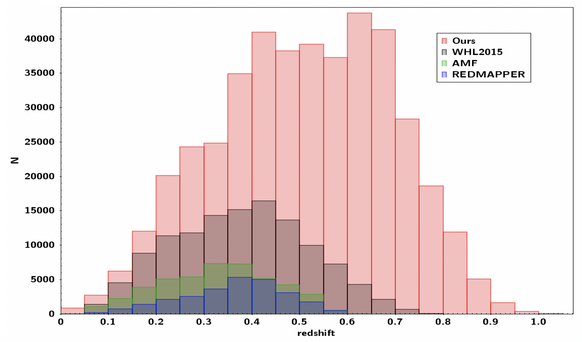NAOC researchers detected the largest number of galaxy clusters
Galaxy clusters are the largest gravitationally bound systems in the universe, which contain a lot of galaxies, gas, and dark matter. They are ideal laboratories to study galaxy formation and evolution in dense environments and also excellent probes to explore the large-scale structure, dark matter, and dark energy.
A large sample of galaxy clusters at z < 1 is fundamental for accurately analyzing the late evolution of galaxies in dense environment, especially for those brightest cluster galaxies (BCGs).
Recently, a research team led by Dr. Hu Zou from National Astronomical Observatories of CAS (NAOC) has utilized the deep imaging data from the Dark Energy Spectroscopic Instrument (DESI) imaging surveys and detected more than 540,000 galaxy clusters at z < 1. These clusters are by far the largest sample that has been found.

Figure 1: Redshift distribution of the galaxy clusters detected by Hu Zou et al. Others are the redshift distributions of the clusters that are found using the SDSS imaging data. The distributions are scaled by the survey area. (Credit: NAOC)
Their work was published in The Astrophysical Journal Supplement Series on April 13, 2021.
As the first series of works, the galaxy clusters detected in this work will be used for further studying the properties of member galaxies, evolution of massive central galaxies, mass assembly and star formation in dense environment, and gas properties in clusters, etc.
Through international collaboration, Dr. Hu Zou has participated the DESI project and conducted large-scale multi-wavelength imaging surveys. One of the imaging components is the Beijing-Arizona Sky Survey (BASS). Dr. Hu Zou is the duty PI of the BASS survey, which is the most successful photometric survey in China.
Before using the imaging data to detect galaxy clusters, Dr. Hu Zou has accurately estimated the photometric redshifts and stellar masses of about 0.3 billion galaxies with r<23. Based on the photometric redshift catalog, he adopted a new fast peak clustering algorithm and detected more than 540,000 galaxy clusters with the number of members larger than 10.
By contrast with those cluster finders based on red sequence, Dr. Hu Zou can detect the clusters that are lack of red galaxies. Compared with traditional overdensity detecting methods, the speed performance of the new method is better and member galaxies can be easily identified. In addition, Dr. Hu Zou has preliminarily found more than a hundred strong lensing systems among these clusters.

Figure 2: One of the detected clusters at the redshift of about 0.4. Some properties of the cluster and the brightest cluster galaxy (BCG) are displayed. The small circle shows the position of the BCG. The cross marks the average position of the member galaxies. The big circle shows the distance of 0.5 Mpc from the BCG. In this figure, we can see the arc signals of strong lensing around the BCG. (Credit: NAOC)
This work will be very much useful for the data analyses and scientific studies of future Chinese large telescopes and large-scale surveys, such as CSST.
The paper can be accessed at https://doi.org/10.3847/1538-4365/abe5b0